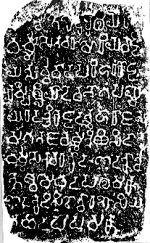History of the Kannada Literature - I
by Dr. (Mrs)
Jyotsna Kamat
First Online: May 23, 2000
Last updated on : December 07, 2024
Kannada is the language predominant in the state of
Karnataka in India. In this special feature
at Kamat's Potpourri, Dr.
Kamat who is an authority on medieval and ancient Kannada
literature, traces the history of the Kannada Language. The first of the series covers the earliest
texts and determines the origins. She then covers the great Jain and
Veerashaiva works. - Ed.
History of Kannada Literature
Early History | Jaina
Works | Medieval Kannada
Vachana Literature | Dasa Sahitya | Epics | Modern Kannada
Early History
Perhaps being the oldest language next to Sanskrit, Prakrit, and Tamil, Kannada country and language
have a rich heritage. 'Kavirajamarga' (![]() )
of king Nripatunga (9th century A.D.) is believed to be the
earliest literary work in Kannada. It is a treatise on poetics or a guide to poets indicating that
Kannada was a fully developed literary language when Kavirajamarga was composed. It refers to
earlier linguists and poets whose works are not forthcoming. But from epigraphical
evidence it can be surmised that the spoken Kannada language evolved much earlier
than the Halmidi inscription (c. 450 A.D. ). Belonging to the Prto-Dravidian
group it has
close affinity with the Tamil language, prevalent now in the neighboring Tamil
Nadu. But the language of the Halmidi inscription is highly Sanskritized.
)
of king Nripatunga (9th century A.D.) is believed to be the
earliest literary work in Kannada. It is a treatise on poetics or a guide to poets indicating that
Kannada was a fully developed literary language when Kavirajamarga was composed. It refers to
earlier linguists and poets whose works are not forthcoming. But from epigraphical
evidence it can be surmised that the spoken Kannada language evolved much earlier
than the Halmidi inscription (c. 450 A.D. ). Belonging to the Prto-Dravidian
group it has
close affinity with the Tamil language, prevalent now in the neighboring Tamil
Nadu. But the language of the Halmidi inscription is highly Sanskritized.

A Banavasi Inscription in Old Kannada
By the
10th century Kannada had its greatest ancient poets like Pampa (born 902 A.D.), Ranna ( born 949
A.D.) and special prose work like Waddaradhane (![]() )
(c. 930 A.D.) indicating that classical Kannada
literature had fully evolved at least one or two centuries earlier, back to 'Kavirajamarga'. But since none of the earlier works have survived, we have to stick to
the established norm that written Kannada came into vogue by the 5th century A.D.
)
(c. 930 A.D.) indicating that classical Kannada
literature had fully evolved at least one or two centuries earlier, back to 'Kavirajamarga'. But since none of the earlier works have survived, we have to stick to
the established norm that written Kannada came into vogue by the 5th century A.D.
Three Phases
For the sake of the convenient study of Kannada language and literature, the pundits have divided the development of Kannada language into three phases; The Old Kannada Phase, The Middle Kannada Phase, and The Modern Kannada Phase.
The verse-form being the most popular all religious texts, scientific treaties like elephant love, horse love, or science of rains, mathematic, poetic, and literature works were composed only in verse- form. India has had oral system of education through the ages and the verse form fit this system very well. The subjects were thought through chanting and reciting and great stress was laid on memorizing, oral reproduction, and application. The verse-form helped to recite easier and to memorize better!
Most of the works in
literature and secular sciences mentioned in reference books like Kavirajamarga are still not to be
traced. But works of later centuries mention now extinct works on various topics. Thus,
Chudamani (a 96,000 verse-measures), a commentary on logic (![]() Tatwarthamahashastra) by Tambulacharya belonged to
the 7th century. Naturally, no shastra (science) treatise could be written so
voluminously unless the language in vogue is not fully developed. Epigraphs prove the
antiquity of the Kannada language.
Tatwarthamahashastra) by Tambulacharya belonged to
the 7th century. Naturally, no shastra (science) treatise could be written so
voluminously unless the language in vogue is not fully developed. Epigraphs prove the
antiquity of the Kannada language.
The students of Kannada language are familiar with the eulogy of Kappe Arabhatta, a hero remembered as Kaliyuga Vipartitan.

Good to the good, sweet to the sweet,
This exceptional man of Kaliyuga
Is a veritable Madhava himself (to the distressed).
This rock stone
inscription of Badami in archaic Kannada letters is ascribed to the 7th century.
The three liner Tripadi ( ![]() which by itself is as old as the Gayatri Mantram ) type of literature was later popularized by the poet
Sarvajna in his 'Vachanas'.
which by itself is as old as the Gayatri Mantram ) type of literature was later popularized by the poet
Sarvajna in his 'Vachanas'.
|
Continued as History of Kannada Literature II |
History of Kannada Literature
Early History | Jaina
Works | Medieval Kannada
Vachana Literature | Dasa Sahitya | Epics | Modern Kannada
Coming Soon:
- Evolution of the Kannada Language
- Literary Pearls of Kannada
See Also:
- Modern Kannada Writers - a treasure house of rare portraits at Kamat's Potpourri
- History of Konkani Language
- Jyotsna Kamat's Home Page
- Jai Karnataka -- Potpourri of topics on
Kannada art and culture.
